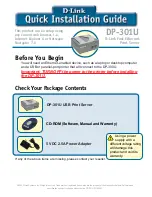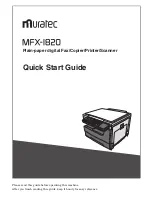
2 - 8
Chapter 2 Troubleshooting
Paper Characteristics
The following paper characteristics affect print quality and reliability. It recommends that you follow
these guidelines when evaluating new paper stock.
Weight
The tray automatically feeds paper weights from 60 g/m
2
to 216 g/m
2
(16 lb to 80 lb bond) grain long.
The single sheet feeder automatically feeds paper weights from 60 g/m
2
to 216 g/m
2
(16 lb to 80 lb
bond) grain long. Paper lighter than 60 g/m
2
(16 lb) may not feed properly, and could cause paper jams.
For best performance, use 75 g/m
2
(20 lb bond) grain long paper.
Curl
Curl is the tendency of print media to curve at its edges. Excessive curl can cause paper feeding
problems. Curl usually occurs after the paper passes through the printer, where it is exposed to high
temperatures. Storing paper unwrapped, even in the paper tray, can contribute to paper curling prior to
printing and cause feeding problems regardless of humidity. When printing on curled paper, straighten
the paper and then insert it into the single sheet feeder.
Smoothness
The degree of paper smoothness directly affects the print quality. If the paper is too rough, the toner does
not fuse on to the paper properly, resulting in poor print quality. If the paper is too smooth, it can cause
paper feeding problems. Smoothness between 150 and 250 Sheffield points produces the best print
quality.
Moisture Content
The amount of moisture in the paper affects both the print quality and the ability of the printer to feed
the paper properly. Leave the paper in its original packaging until you are ready to use it. This limits the
exposure of the paper to moisture changes that can degrade its performance.
Grain Direction
Grain refers to the alignment of the paper fibers in a sheet of paper. Grain is either grain long, running
the length of the paper, or grain short, running the width of the paper. For 60 g/m
2
to 135 g/m
2
(16 lb to
36 lb bond) paper, grain long fibers are recommended. For paper heavier than 135 g/m
2
(36 lb bond),
grain short is preferred.
Fiber Content
Most high-quality xerographic paper is made from 100% chemically pulped wood. Paper containing
fibers such as cotton may lead to degraded paper handling.
Recommended Paper
To ensure the best print quality and feed reliability, use 75 g/m
2
(20 lb) xerographic paper. Business
paper designed for general business use also provides acceptable print quality. Only use paper able to
withstand high temperatures without discoloring, bleeding, or releasing hazardous emissions. The laser
printing process heats paper to high temperatures. Check with the manufacturer or vendor to determine
whether the paper you have chosen is acceptable for laser printers.
It is recommended that you perform trial print before purchasing large quantities of print media. When
choosing any print media, you should consider the weight, fiber content, and color.
Unusable Paper
The following paper types are not recommended for use with the printer.
1) Chemically treated papers used to make copies without carbon paper, also known as carbonless
papers, carbonless copy paper (CCP), or no carbon required (NCR) paper
2) Preprinted papers with chemicals that may contaminate the printer
3) Preprinted papers that can be affected by the temperature in the printer fusing unit
Summary of Contents for DocuPrint CM305 df
Page 1: ...DocuPrint CM305 df Service Manual 1st Edition ...
Page 2: ......
Page 4: ...Company Name Department Name Telephone No Full Name Employee No ...
Page 6: ......
Page 7: ...Preface ...
Page 8: ......
Page 10: ......
Page 15: ...Chapter 1 Service Call Procedure ...
Page 16: ......
Page 18: ......
Page 28: ...1 10 Chapter 1 Service Call Procedure Blank Page ...
Page 29: ...Chapter 2 Troubleshooting ...
Page 30: ......
Page 218: ...2 184 Chapter 2 Troubleshooting Blank Page ...
Page 219: ...Chapter 3 Image Quality Troubleshooting ...
Page 220: ......
Page 222: ......
Page 271: ...Chapter 4 Disassembly Assembly and Adjustments ...
Page 272: ......
Page 276: ......
Page 281: ...4 5 Chapter 4 Disassembly Assembly and Adjustments Blank Page ...
Page 285: ...4 9 Chapter 4 Disassembly Assembly and Adjustments Blank Page ...
Page 291: ...4 15 Chapter 4 Disassembly Assembly and Adjustments Blank Page ...
Page 295: ...4 19 Chapter 4 Disassembly Assembly and Adjustments Blank Page ...
Page 301: ...4 25 Chapter 4 Disassembly Assembly and Adjustments Blank Page ...
Page 319: ...4 43 Chapter 4 Disassembly Assembly and Adjustments Blank Page ...
Page 335: ...4 59 Chapter 4 Disassembly Assembly and Adjustments Blank Page ...
Page 337: ...4 61 Chapter 4 Disassembly Assembly and Adjustments Blank Page ...
Page 365: ...4 89 Chapter 4 Disassembly Assembly and Adjustments Blank Page ...
Page 373: ...4 97 Chapter 4 Disassembly Assembly and Adjustments Blank Page ...
Page 413: ...4 137 Chapter 4 Disassembly Assembly and Adjustments Blank Page ...
Page 417: ...4 141 Chapter 4 Disassembly Assembly and Adjustments Blank Page ...
Page 421: ...4 145 Chapter 4 Disassembly Assembly and Adjustments Blank Page ...
Page 429: ...4 153 Chapter 4 Disassembly Assembly and Adjustments Blank Page ...
Page 435: ...4 159 Chapter 4 Disassembly Assembly and Adjustments Blank Page ...
Page 443: ...4 167 Chapter 4 Disassembly Assembly and Adjustments Blank Page ...
Page 451: ...4 175 Chapter 4 Disassembly Assembly and Adjustments Blank Page ...
Page 471: ...4 195 Chapter 4 Disassembly Assembly and Adjustments Blank Page ...
Page 485: ...4 209 Chapter 4 Disassembly Assembly and Adjustments Blank Page ...
Page 491: ...4 215 Chapter 4 Disassembly Assembly and Adjustments 4 Remove the MEMORY CARD ...
Page 507: ...4 231 Chapter 4 Disassembly Assembly and Adjustments Blank Page ...
Page 511: ...4 235 Chapter 4 Disassembly Assembly and Adjustments 10 Remove the PWBA LVPS from the printer ...
Page 513: ...4 237 Chapter 4 Disassembly Assembly and Adjustments Blank Page ...
Page 521: ...4 245 Chapter 4 Disassembly Assembly and Adjustments Blank Page ...
Page 527: ...4 251 Chapter 4 Disassembly Assembly and Adjustments Blank Page ...
Page 533: ...4 257 Chapter 4 Disassembly Assembly and Adjustments Blank Page ...
Page 575: ...4 299 Chapter 4 Disassembly Assembly and Adjustments Blank Page ...
Page 577: ...4 301 Chapter 4 Disassembly Assembly and Adjustments Blank Page ...
Page 581: ...4 305 Chapter 4 Disassembly Assembly and Adjustments Blank Page ...
Page 592: ...4 316 Chapter 4 Disassembly Assembly and Adjustments Blank Page ...
Page 593: ...Chapter 5 Parts List ...
Page 594: ......
Page 642: ...5 46 Chapter 5 Parts List Blank Page ...
Page 643: ...Chapter 6 General ...
Page 644: ......
Page 660: ...6 14 Chapter 6 General Chart Parallelism Perpendicularity ...
Page 661: ...6 15 Chapter 6 General Skew Linearity Magnification Error Registration ...
Page 774: ...6 128 Chapter 6 General Blank Page ...
Page 775: ...Chapter 7 Wiring Data ...
Page 776: ......
Page 778: ......
Page 786: ...7 8 Chapter 7 Wiring Data 7 1 2 2 OPTION Duplex ...
Page 788: ...7 10 Chapter 7 Wiring Data 7 2 Wire Nerwork Undescribed ...
Page 789: ...7 11 Chapter 7 Wiring Data 7 3 BSD Undescribed ...
Page 822: ...7 44 Chapter 7 Wiring Data Blank Page ...
Page 823: ...Chapter 9 Installation and Removal ...
Page 824: ......
Page 826: ......
Page 836: ...9 10 Chapter 9 Installation and Removal 9 2 Removal Undescribed ...
Page 837: ...Chapter 10 Machine Overview ...
Page 838: ......
Page 840: ......
Page 852: ...10 12 Chapter 10 Machine Overview Blank Page ...
















































